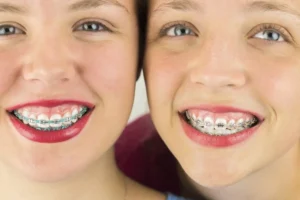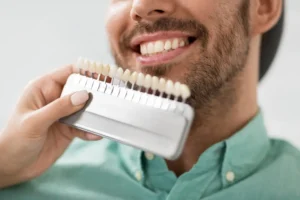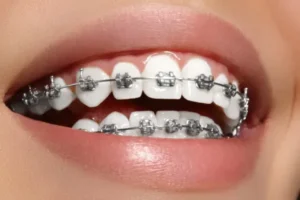We all scream for some ice cream once in a while, and those of us undergoing braces treatment are no exception. The good news is that you can still eat ice cream with braces and, in certain situations, it is recommended. However, ice cream is still high in fats and sugars, and should be limited to an occasional treat. There are also certain flavors that contain nuts, candies, or other items that may be too hard to chew.
Article written by Diamond Braces Clinical Staff
Article medically reviewed by Dr. Oleg Drut
Can I Eat Ice Cream With Braces?
Yes, you can eat ice cream while wearing braces. In fact, ice cream is one of the foods we recommend that you eat during the first week of braces treatment. Ice cream can soothe your sore teeth as they get used to your new braces.
When eating ice cream with sore teeth from braces, it’s important to choose the right flavors and types. This ensures you don’t harm your braces or delay your orthodontic treatment. Select ice creams that are gentle on your teeth, avoiding those that are too hard or sticky.
To maintain oral hygiene while enjoying cold treats, it’s important to brush your teeth regularly. This helps prevent tooth decay and gum disease. Enjoying ice cream can soothe sore teeth, especially for those with traditional metal braces. It’s good to understand how braces work to protect dental health. Regular brushing is key in keeping teeth healthy while enjoying your favorite treats.

Avoid Hard or Frozen Ice Cream
Avoid hard or frozen ice cream with braces. Eating extremely cold foods can make your teeth feel sensitive, which can be more pronounced when you have braces. Ice cream that’s too hard can also be uncomfortable when you’re just starting with braces. To enjoy your ice cream without any issues, eat it slowly and be cautious not to bite into a hard chunk or trigger a brain freeze.
When choosing plain ice cream flavors with braces, keep in mind that softer options are better. If you have Invisalign instead of braces, you may still want to be careful with very cold or hard ice cream to prevent discomfort. Enjoy your ice cream at a comfortable pace to avoid any unwanted dental sensitivity or discomfort.
To enjoy soft-serve ice cream or frozen yogurt from your favorite shop, or when you’re at home, consider placing your ice cream in the microwave. Softer ice creams are easier to eat, allowing you to avoid exerting too much pressure on your teeth. This gentle approach to indulging in frozen treats can be particularly beneficial for individuals with brackets and wires, ceramic braces, or lingual braces.
Soft-serve ice cream and frozen yogurt, when obtained from a beloved shop, offer a delightful way to satisfy your sweet cravings. Alternatively, if you’re in the comfort of your home, a quick microwave session can make your ice cream easier to scoop and enjoy. This method is especially advantageous for those wearing brackets and wires, ceramic braces, or lingual braces, as it minimizes the strain on your teeth while still allowing you to savor your favorite frozen delights.

Stick With Plain Flavors
When you’re looking for a sweet treat, choose flavors that don’t have crunchy, sticky, or hard bits. Unfortunately, this means you may have to stick with plain ice cream flavors throughout your braces journey. This is because complex flavors full of bits can get stuck in your braces. You may have to avoid chocolate chip cookie dough, rocky road, pistachio with nuts, and others while you’re wearing braces.

Maintain Your Oral Care Routine
Orthodontic waxes, commonly used for tooth movement with braces, generally do not trigger adverse reactions in individuals with conditions like a dairy allergy or Celiac Disease. Most orthodontic waxes are gluten and dairy-free, and they have rarely been associated with any adverse reactions. These waxes are designed to be safe for use with braces and are tooth-colored, so they blend in discreetly.
If you have concerns about potential reactions to orthodontic wax, it’s a good idea to check the product’s ingredients to ensure it does not contain any allergens that may affect you. However, in general, using orthodontic wax to address discomfort or prevent braces from causing damage to your braces should not pose a risk to individuals with dairy allergies or Celiac Disease. Additionally, when eating cold foods, be mindful of any wax residue, as it may harden and become uncomfortable, but this is not related to allergens.
Check labels for gluten and dairy-free options, but also read fine print for hidden ingredients. Review product labels and user feedback. If unsure, consult your orthodontist for wax recommendations.

What is the Conclusion
Wax products used for orthodontic purposes have a long shelf life. They can last for more than 10 years if stored correctly. This is important for those who use wires and brackets in their treatment plans. Proper storage ensures the wax maintains its benefits.
Orthodontic wax can become hard and lose its ability to bond if it is not stored properly. Always keep the wax container closed when it’s not in use. This helps maintain the quality of the wax. Remember, good oral hygiene, including the need to brush and floss regularly, is crucial during orthodontic treatment.






